What are Spider Veins?
Spider veins are the thread-like colored veins most often seen on the surface of the skin. They are most often not as painful as enlarged varicose veins but they are still liable to bleed and worsen without treatment. Varicose veins occur most commonly in the legs but are often seen in the face and elsewhere. These varicose veins, medically referred to as telangectasias, will not worsen to the point where they will ever become the large bulging varicose veins.
What are Spider Veins?
Varicose veins are the thread-like colored veins most often seen on the surface of the skin. They are most often not as painful as enlarged varicose veins but they are still liable to bleed and worsen without treatment. Spider veins occur most commonly in the legs but are often seen in the face and elsewhere. These veins, medically referred to as telangectasias, will not worsen to the point where they will ever become the large bulging varicose veins.
Why treat spider veins and varicose veins?
Some people desire treatment for cosmetic reasons only and others for the medical benefits it will provide to the legs. Without treatment, the leg veins will enlarge and worsen with time. The circulatory system tends to suffer more disease with age, be it increasing hardening of the arteries, increased likelihood of heart attack or stroke, or a worsening of the spider veins and/or varicose veins. It may occur gradually or rapidly but the condition almost surely will become more severe. Patients who seek vein treatment for medical reasons may fear problems in the future or may be symptomatic already. Typical symptoms from venous insufficiency and varicose veins are heavy, achy, drawing pains, swelling, (edema), tenderness to touch, and a tired feeling in the legs. In women, these symptoms are often made worse when a woman is about to menstruate. Most often as the veins themselves worsen so do the symptoms.
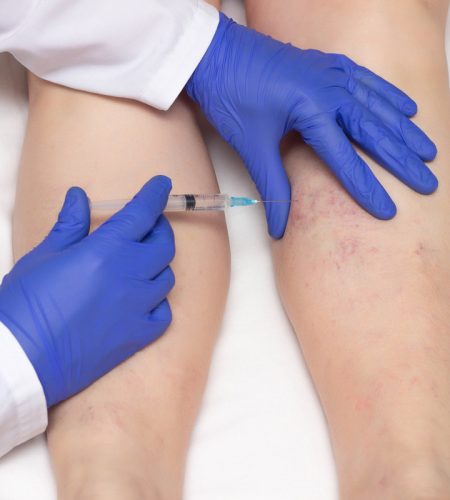
Untreated, the varicose veins may lead to other medical problems. As they enlarge they can cause worsening venous insufficiency which is a congestion of the venous blood that is unable to return from the legs to the heart. Venous insufficiency itself leads to other ailments, the most common of which are blood clots (phlebitis), leg ulcers (breaks in the skin), bleeding infection, and stasis (skin) changes in the legs. A more detailed explanation of these conditions is below under phlebitis and venous insufficiency.
Why treat spider veins and varicose veins?
Some people desire treatment for cosmetic reasons only and others for the medical benefits it will provide to the legs. Without treatment, the leg veins will enlarge and worsen with time. The circulatory system tends to suffer more disease with age, be it increasing hardening of the arteries, increased likelihood of heart attack or stroke, or a worsening of the veins and/or varicose veins. It may occur gradually or rapidly but the condition almost surely will become more severe. Patients who seek vein treatment for medical reasons may fear problems in the future or may be symptomatic already. Typical symptoms from venous insufficiency and varicose veins are heavy, achy, drawing pains, swelling, (edema), tenderness to touch, and a tired feeling in the legs. In women, these symptoms are often made worse when a woman is about to menstruate. Most often as the veins themselves worsen so do the symptoms.
Untreated, the varicose veins and spider veins may lead to other medical problems. As they enlarge they can cause worsening venous insufficiency which is a congestion of the venous blood that is unable to return from the legs to the heart. Venous insufficiency itself leads to other ailments, the most common of which are blood clots (phlebitis), leg ulcers (breaks in the skin), bleeding infection, and stasis (skin) changes in the legs. A more detailed explanation of these conditions is below under phlebitis and venous insufficiency.
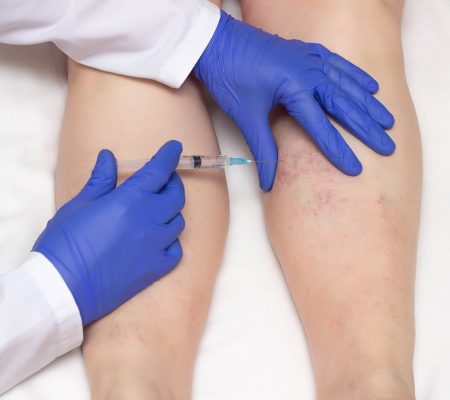
How to treat varicose and spider veins?
The old saying “there are many ways to skin a cat” applies to the many types of therapy available to help patients with both varicose veins and spider veins. A conservative treatment is support stockings to be put on before getting out of bed in the morning and worn all day. This will not make either the spider or varicose veins go away and probably not even prevent any leg veins from worsening but it may provide some symptomatic relief while being worn. Stockings can be custom-fit or bought over the counter and both types are available in different degrees of compression.
Injections of medications into veins is known as sclerotherapy. It has been a successful method of treating both spider veins as well as varicose veins since the 1600s. The medicines used in sclerotherapy act upon the inner lining of the vein walls to gradually cause them to seal shut and stop the flow of blood through them. This method of treatment may be employed to treat the large ropey varicose veins and the smaller spider veins as well. Today, sclerotherapy is, without question, the most popular method employed by vascular specialists worldwide, to help eliminate unwanted veins. It is minimally invasive and very effective if done correctly by experienced doctors. In some situations ‘foam sclerotherapy’ can be done. Foam sclerotherapy is nearly identical to ‘regular’ injection therapy except that the medications are mixed with air to give it a foamy texture as opposed to its normal liquid state. Both are done in a doctor’s office on an outpatient basis and no anesthesia is necessary.
Ambulatory phlebectomy is a slightly more invasive surgery in which multiple incisions are made along the varicose vein and it is literally “fished-out” of the leg using surgical hooks. A minority of doctors prefer this method over sclerotherapy or classic stripping and ligation surgery and it is not a treatment option for the spider veins. It is done in either an operating room or the ‘treatment room’ in an office, using either local or regional anesthesia.
Stripping and ligation is classic invasive surgery to tie the varicose veins shut and remove them from the leg. It will certainly remove those leg veins that are operated on but will leave scars from the incisions and it can only be employed to treat very enlarged varicose veins. It is done in an operating room with either general or local anesthesia and is most often done on an outpatient basis.
How to treat varicose and spider veins?
The old saying “there are many ways to skin a cat” applies to the many types of therapy available to help patients with both varicose veins and spider veins. A conservative treatment is support stockings to be put on before getting out of bed in the morning and worn all day. This will not make either the spider or varicose veins go away and probably not even prevent any leg veins from worsening but it may provide some symptomatic relief while being worn. Stockings can be custom-fit or bought over the counter and both types are available in different degrees of compression.
Injections of medications into veins is known as sclerotherapy. It has been a successful method of treating both spider veins as well as varicose veins since the 1600s. The medicines used in sclerotherapy act upon the inner lining of the vein walls to gradually cause them to seal shut and stop the flow of blood through them. This method of treatment may be employed to treat the large ropey varicose veins and the smaller spider veins as well. Today, sclerotherapy is, without question, the most popular method employed by vascular specialists worldwide, to help eliminate unwanted veins. It is minimally invasive and very effective if done correctly by experienced doctors. In some situations ‘foam sclerotherapy’ can be done. Foam sclerotherapy is nearly identical to ‘regular’ injection therapy except that the medications are mixed with air to give it a foamy texture as opposed to its normal liquid state. Both are done in a doctor’s office on an outpatient basis and no anesthesia is necessary.
Ambulatory phlebectomy is a slightly more invasive surgery in which multiple incisions are made along the varicose vein and it is literally “fished-out” of the leg using surgical hooks. A minority of doctors prefer this method over sclerotherapy or classic stripping and ligation surgery and it is not a treatment option for the spider veins. It is done in either an operating room or the ‘treatment room’ in an office, using either local or regional anesthesia.
Stripping and ligation is classic invasive surgery to tie the varicose veins shut and remove them from the leg. It will certainly remove those leg veins that are operated on but will leave scars from the incisions and it can only be employed to treat very enlarged varicose veins. It is done in an operating room with either general or local anesthesia and is most often done on an outpatient basis.
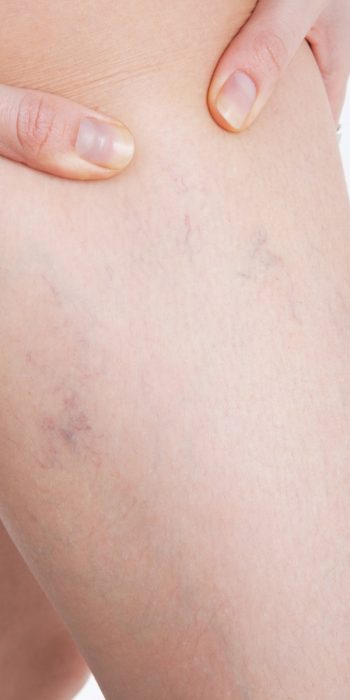
Why do leg veins occur?
Veins most often dilate and become varicose as a result of increased downward pressure on the vein from a point above it. The pressure can be something as temporary as pregnancy or the straining associated with moving your bowels (both of which increase the abdominal pressure), or as constant as the forces of gravity and your own body weight. Medical studies have found that the composition of varicosities walls is different from that of normal vein walls thus suggesting something inherently different about varicose veins themselves. Patients often say there is a family history of varicose and spider veins and this most likely will increase one’s chances of suffering from them in the future. It is rare but some people are born without the one-way valves that help prevent venous blood from flowing downward instead of upward toward the heart. More commonly however these valves are not functioning correctly as is seen after having suffered prior phlebitis (blood clot). People who spend lots of time on their feet may increase their chances of getting varicose and spider veins.
Spider veins, unlike varicose veins, most often do not occur in response to increased pressure except for the pressure created by nearby varicosities themselves. They often arise from the presence of the female hormone estrogen which is most likely why these spider veins are seen more commonly in females. Women also are known to have more development of spider veins when their body estrogen levels are elevated such as when they are pregnant when taking oral contraceptives, and obviously when on estrogen replacement therapy.
Why do leg veins occur?
Veins most often dilate and become varicose as a result of increased downward pressure on the vein from a point above it. The pressure can be something as temporary as pregnancy or the straining associated with moving your bowels (both of which increase the abdominal pressure), or as constant as the forces of gravity and your own body weight. Medical studies have found that the composition of varicosities walls is different from that of normal vein walls thus suggesting something inherently different about varicose veins themselves. Patients often say there is a family history of varicose and spider veins and this most likely will increase one’s chances of suffering from them in the future. It is rare but some people are born without the one-way valves that help prevent venous blood from flowing downward instead of upward toward the heart. More commonly however these valves are not functioning correctly as is seen after having suffered prior phlebitis (blood clot). People who spend lots of time on their feet may increase their chances of getting varicose and spider veins.
Spider veins, unlike varicose veins, most often do not occur in response to increased pressure except for the pressure created by nearby varicosities themselves. They often arise from the presence of the female hormone estrogen which is most likely why these spider veins are seen more commonly in females. Women also are known to have more development of spider veins when their body estrogen levels are elevated such as when they are pregnant when taking oral contraceptives, and obviously when on estrogen replacement therapy.
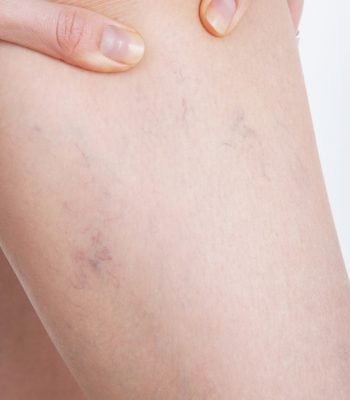
What are phlebitis and venous insufficiency?
When the blood in the varicose and spider veins stagnates in the legs it causes pooling of that blood known as venous congestion. Venous congestion is most evident when the legs are below the heart and least evident when they are at the heart level, for example when lying in bed. The inability to adequately move the blood that is below the heart upward towards the heart is known as venous insufficiency. This stagnant blood in the veins causes many of the symptoms that patients with veins complain of, such as swelling (edema), tired and heavy legs, throbbing in the legs, drawing pains, and pain to touch. This is often relieved when the leg is elevated. Venous insufficiency can become chronic which is a more serious problem in that it increases the risk of ulceration (breaks in the skin) in the legs and phlebitis (blood clots). With chronically high pressure on the veins, blood cells are thought to be forced out of the veins and capillaries and deposited into the surrounding tissue. The subsequent breakdown of these red blood cells causes a dark ‘rusty’ look to the legs most often on the inner ankles and most importantly creates a barrier through which oxygen and nutrient transfer is lessened. This overlying skin is more prone to ulceration (holes in the skin) from any minor injury, such as a bump, scratch, or bug bite.
Phlebitis (blood clots) is the result of stagnant blood that has clotted (congealed) within a vein. Phlebitis generally occurs when the already slowed blood flow in the varicose veins becomes slower or the body’s clotting mechanisms are stimulated. A long trip in a plane or car, where your legs are not moving much is a common scenario for the start of phlebitis. So is a minor trauma to the legs that ‘turns on’ the body’s clotting mechanisms. In certain cases, phlebitis is extremely dangerous and in others, it is very benign, depending on which veins are involved. The greatest danger with certain clots is that they may break free from the leg veins and travel to the lungs. These emboli (the name for clots that have traveled to the lungs) then block the proper functioning of the heart and lungs and can result in death. Even those blood clots that don’t leave the leg veins are problematic both while in their acute phase and in years to come. Acutely they can cause pain, tenderness throbbing, and discomfort. More long term, the leg, and veins affected will suffer further venous insufficiency which generally worsens over future years.
How does therapy help?
The treatment and elimination of the varicose and spider veins allows the venous side of the circulatory system to be improved. By eliminating these veins, the blood is forced into other better functioning blood vessels to be returned to the heart. The blood that was pooled in the varicose and spider veins is no longer stationary and stagnant as the veins have been sealed shut and removed from the circulatory system. After the veins have been eliminated patients whose symptoms were related to venous congestion and insufficiency often experience relief. This is because without that stagnant blood swelling up the varicose and spider veins, your legs should feel less heavy and tired. Of course, if your leg pain is not due to venous problems vein treatment will improve the appearance of the leg but may have no bearing on how the leg feels. Examples of leg pain not caused by varicose or spider veins and thus not relieved by treatment are sciatica, arterial problems (hardening of the arteries), and arthritis to name just a few.
What are phlebitis and venous insufficiency?
When the blood in the varicose veins in feet and spider veins stagnates in the legs it causes pooling of that blood known as venous congestion. Venous congestion is most evident when the legs are below the heart and least evident when they are at the heart level, for example when lying in bed. The inability to adequately move the blood that is below the heart upward towards the heart is known as venous insufficiency. This stagnant blood in the spider veins of ankles causes many of the symptoms that patients with veins complain of, such as swelling (edema), tired and heavy legs, throbbing in the legs, drawing pains, and pain to touch. This is often relieved when the leg is elevated. Venous insufficiency can become chronic which is a more serious problem in that it increases the risk of ulceration (breaks in the skin) in the legs and phlebitis (blood clots). With chronically high pressure on the veins, blood cells are thought to be forced out of the veins and capillaries and deposited into the surrounding tissue. The subsequent breakdown of these red blood cells causes a dark ‘rusty’ look to the legs most often on the inner ankles and most importantly creates a barrier through which oxygen and nutrient transfer is lessened. This overlying skin is more prone to ulceration (holes in the skin) from any minor injury, such as a bump, scratch, or bug bite.
Phlebitis (blood clots) is the result of stagnant blood that has clotted (congealed) within a vein. Phlebitis generally occurs when the already slowed blood flow in the varicose veins becomes slower or the body’s clotting mechanisms are stimulated. A long trip in a plane or car, where your legs are not moving much is a common scenario for the start of phlebitis. So is a minor trauma to the legs that ‘turns on’ the body’s clotting mechanisms. In certain cases, phlebitis is extremely dangerous and in others, it is very benign, depending on which veins are involved. The greatest danger with certain clots is that they may break free from the leg veins and travel to the lungs. These emboli (the name for clots that have traveled to the lungs) then block the proper functioning of the heart and lungs and can result in death. Even those blood clots that don’t leave the foot veins are problematic both while in their acute phase and in years to come. Acutely they can cause pain, tenderness throbbing, and discomfort. More long term, the leg, and veins affected will suffer further venous insufficiency which generally worsens over future years.
How does therapy help?
The treatment and elimination of the varicose and spider veins allows the venous side of the circulatory system to be improved. By eliminating these veins, the blood is forced into other better functioning blood vessels to be returned to the heart. The blood that was pooled in the varicose and spider veins is no longer stationary and stagnant as the veins have been sealed shut and removed from the circulatory system. After the veins have been eliminated patients whose symptoms were related to venous congestion and insufficiency often experience relief. This is because without that stagnant blood swelling up the varicose and spider veins, your legs should feel less heavy and tired. Of course, if your leg pain is not due to venous problems vein treatment will improve the appearance of the leg but may have no bearing on how the leg feels. Examples of leg pain not caused by varicose or spider veins and thus not relieved by treatment are sciatica, arterial problems (hardening of the arteries), and arthritis to name just a few.
Can varicose veins and spider veins be prevented?
This is a common question patients ask and one for which there is no absolute answer. If you have a family history of varicose or spider veins and it’s something you have inherited there is obviously nothing you can do to change your genes. If you have a rare condition such as the congenital absence of the one-way vein valves it also is something you were born with (or without) and there is little you can do. Being overweight may very well help varicose veins and spider veins to form as this serves to add pressure (weight), onto the legs and make it that much more difficult for the venous blood of the legs to get back up to the heart. Smoking and drinking are not believed to be related to the presence of varicose and spider veins aside from any weight they may add to your body. Diet also, may be only a weight-related issue.
The arteries and veins generally suffer from different medical conditions and the foods we are warned to avoid that are high in fat and cholesterol do cause “hardening of the arteries” but have no effect on the leg veins. Support hose can provide relief from the symptoms of the venous pooling as they act to help ‘squeeze’ the veins so less blood is held in the vessels. It is generally felt that long term, support hose wearing will not prevent veins from forming or cause those veins you already have to disappear.
Your podiatric physician/surgeon has been trained specifically and extensively in the diagnosis and treatment of all manners of foot conditions. This training encompasses all of the intricately related systems and structures of the foot and lower leg including neurological, circulatory, skin, and the musculoskeletal system, which includes bones, joints, ligaments, tendons, muscles, and nerves.
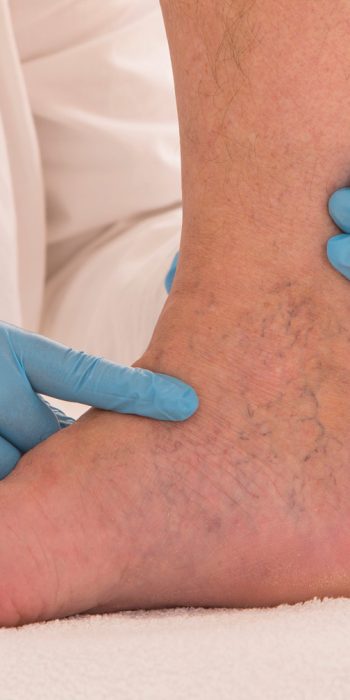
Can varicose veins and spider veins be prevented?
This is a common question patients ask and one for which there is no absolute answer. If you have a family history of varicose or spider veins and it’s something you have inherited there is obviously nothing you can do to change your genes. If you have a rare condition such as the congenital absence of the one-way vein valves it also is something you were born with (or without) and there is little you can do. Being overweight may very well help varicose veins and spider veins to form as this serves to add pressure (weight), onto the legs and make it that much more difficult for the venous blood of the legs to get back up to the heart. Smoking and drinking are not believed to be related to the presence of varicose and spider veins aside from any weight they may add to your body. Diet also, may be only a weight-related issue.
The arteries and veins generally suffer from different medical conditions and the foods we are warned to avoid that are high in fat and cholesterol do cause “hardening of the arteries” but have no effect on the leg veins. Support hose can provide relief from the symptoms of the venous pooling as they act to help ‘squeeze’ the veins so less blood is held in the vessels. It is generally felt that long term, support hose wearing will not prevent veins from forming or cause those veins you already have to disappear.
Your podiatric physician/surgeon has been trained specifically and extensively in the diagnosis and treatment of all manners of foot conditions. This training encompasses all of the intricately related systems and structures of the foot and lower leg including neurological, circulatory, skin, and the musculoskeletal system, which includes bones, joints, ligaments, tendons, muscles, and nerves.
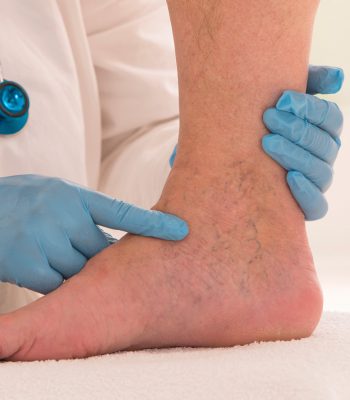
Telephone No.1-855-300-6685
